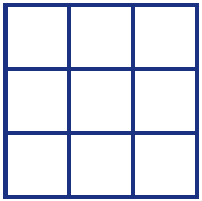This problem solving activity has a number focus.

She decides to make all of the magic squares that she can using the numbers 2.0, 2.2, 2.4, 2.6 and 2.8
How many can she make if she uses each number at least once in the square?
It takes her quite a while because she doesn't know that the sum of a magic square is always three times the number in the centre.
- Use addition with decimals.
- Know the idea of, and be able to construct, magic squares.
A magic square is an arrangement like the one below where the vertical, horizontal and diagonal lines of numbers all add up to the same value. This ‘same value’ is called the sum of the magic square.
| 4 | 1 | 7 |
| 7 | 4 | 1 |
| 1 | 7 | 4 |
Magic squares are interesting objects in both proper and recreational mathematics. It is likely that students have already encountered magic squares. The problems in this sequence give students the opportunity to use known numerical or algebraic concepts.
It’s a critical part of this, and some later problems, that three times the centre square is equal to the sum of the magic square.
This problem is part of a series of Number problems exploring magic squares. The first of these are Little Magic Squares and A Square of Circles at Level 2, and Big Magic Squares at Level 3. At Level 4, Negative Magic Squares, uses negative numbers and Fractional Magic Squares uses fractions. The Magic Square, Level 5 shows why three times the centre number is equal to the sum of the magic square. Finally, Difference Magic Squares (Number and Algebra - Patterns and Relationships) at Level 6, looks at an interesting variation of the magic square concept.
The Problem
Tui likes magic squares. She decides to make all of the magic squares that she can using the numbers 2.0, 2.2, 2.4, 2.6 and 2.8
How many can she make if she uses each number at least once in the square?
It takes her quite a while because she doesn't know that the sum of a magic square is always three times the number in the centre.
Teaching Sequence
- Talk about square ‘arrays’ of numbers like the ones in A Square of Circles. Ask the class if you can put numbers into these arrays so that the rows have the same sum; the columns have the same sum; all of the rows, columns and diagonals have the same sum.
- Show them a magic square such as the one below.
| 6 | 1 | 5 |
| 3 | 4 | 5 |
| 3 | 7 | 2 |
- Have them check that the rows all have the same sum (of 12); that the columns all have the same sum; and that the diagonals have the same sum. This is why they are called magic squares.
- Pose Tui’s problem.
- Have students work individually or in pairs to see how many magic squares they can find.
- As solutions emerge, ask some students to share and to prove that the arrays they have produced are magic squares?
- Pose the Extension problem as appropriate.
Extension
Solution
Students are unlikely to solve the problem the way shown below. Students are more likely to use guess and check and to stumble across the final set of solutions. However, a systematic approach is shown here to show that Tui should have found only one magic square.
You may however want to have your students see that there is a systematic way of finding the solution
|
|
| |||||||||||||||||||||
|
|
|
| |||||||||||||||||||||||||||||||||
|
|
|
| ||||||||||||||||||||||||||||||||||||